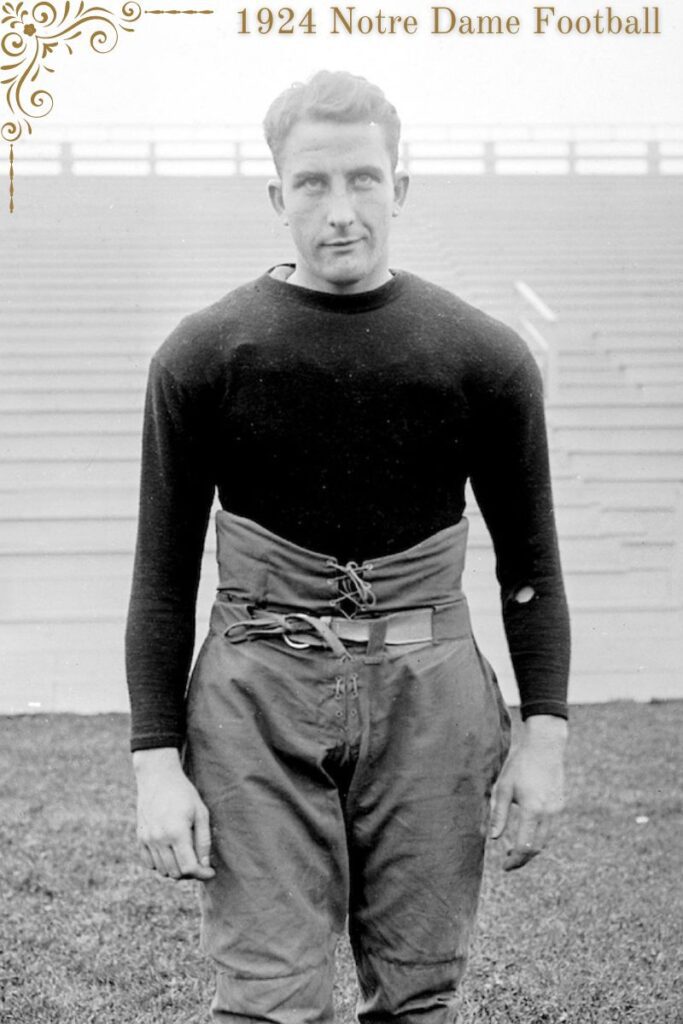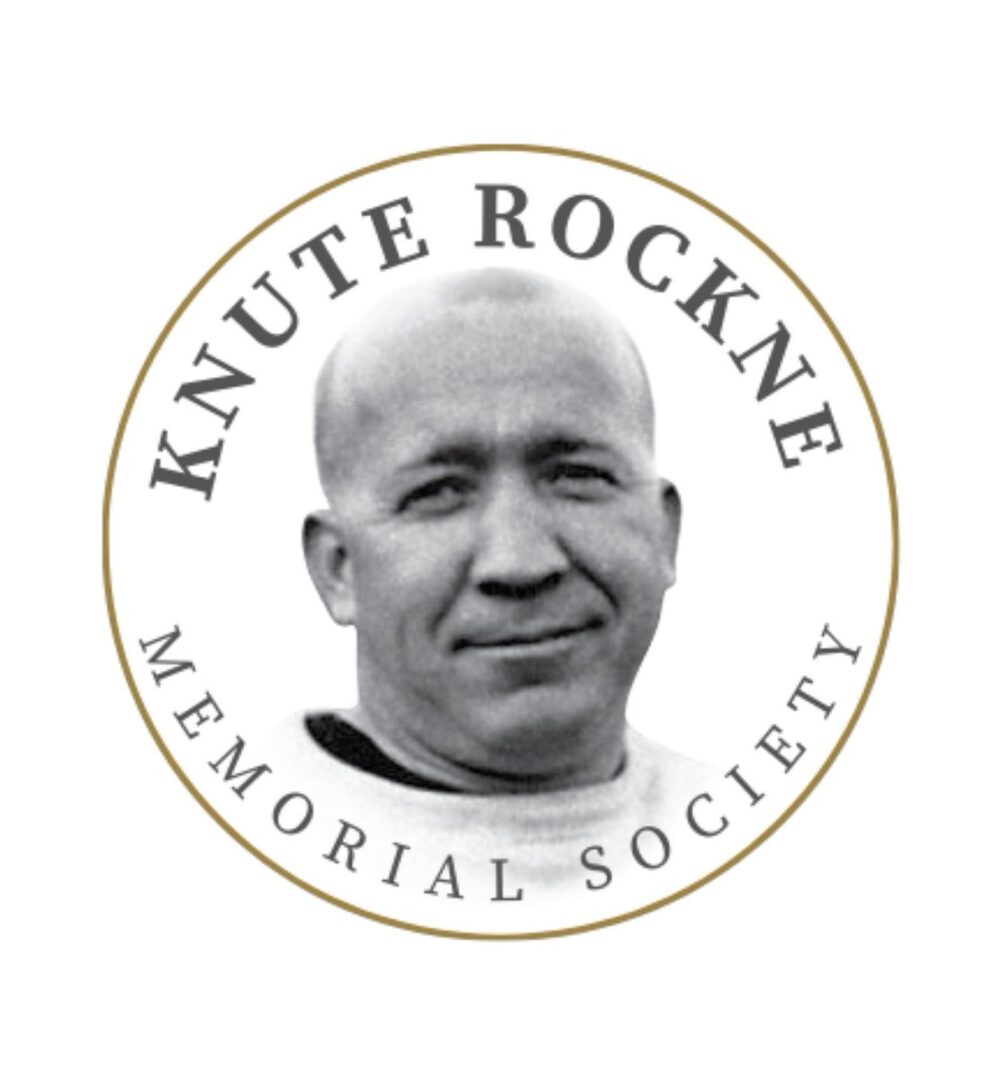
Ed Hunsinger
Right End
Chillicothe, OH
Knute Rockne built his dynasty of champions at Notre Dame without the benefit of anything resembling the player scouting and recruiting that would ensue in future decades.
Especially in his first several years of coaching the Irish, Rockne simply relied on the school’s budding athletic tradition and network of former student-athletes to keep the flow of talented young men headed to South Bend.
On countless occasions, a high school teacher, coach or priest from across the Midwest, sometimes further, would write Rockne extolling the attributes of a high school standout, pointing out the many fine points of the youngster as an athlete, scholar and upstanding citizen.
More often than not, Coach Rockne’s reply was simply, “Send the boy on.”
In other words, get him to campus and let him compete with the couple of hundred others in his class who have dreams of playing football for Notre Dame. Let him work his way onto the freshman team, then compete for playing time and, as a sophomore, we’ll see where he sits among the many candidates for the Irish varsity.
It’s hard to imagine, but in a handful of cases, regulars who played on some of Rockne’s strongest teams did so without the benefit of having played high school football.
One of these was a member of the Seven Mules on the 1924 national champions, right end Edward “Bugs” Hunsinger of Chillicothe, Ohio.
In Chillicothe, Ed Hunsinger attended his parish high school, St. Mary’s, which did not have a football team at the time. In fact, young Edward was one of just six graduates of the high school in 1920. No athletic honors were awarded, but he did receive the school’s Medal of Christian Doctrine.
Hunsinger played some football for a team sponsored by the local Knights of Columbus and was a regular on their baseball team as well. On the hardwood, “the boys of St. Mary’s school have organized a basketball team” with Hunsinger at center. “Bugs” was also a standout performer in many dramatic acts at St. Mary’s.
At Notre Dame, Ed gained more football experience playing on the freshman team in 1921 and in the Interhall league.
Hunsinger then earned a spot on the 1922 varsity as a reserve end, and spent the next two seasons as a backup to Glen Carberry, George Vergara and Gene Mayl. In the Oct. 13, 1923 game vs. Army at Ebbets Field in Brooklyn, Mayl went down with an injury and Hunsinger took his place. With ND clinging to a late lead, “it was a long sweeping run around Hunsinger’s end made by (Jim) Crowley that placed the ball in position for the last touchdown” in the 13-0 win.
With Carberry, Vergara and Mayl gone in 1924, Hunsinger completed his rise up the depth chart and snared the spot as regular right end. At 5-11, 172, he brought good size and great energy to the position, which focused on blocking and tackling much more than receiving passes, the Four Horsemen doing most of the pass-catching those years.
Time and again during the unbeaten 1924 season, Hunsinger came up with a steady play which helped the Irish roll to a 10-0 record and consensus national championship.
Typical was a timely stop when ND’s game at Wisconsin, a 38-3 romp, was still in doubt. “Track star Harry McAndrews tried to circle the end, but was hauled down for a seven-yard loss by Ed Hunsinger.” In the pivotal Nebraska game, a 34-6 win, “everything Nebraska tried was finding its match. Irish ends Collins and Hunsinger hemmed in anything headed wide.”
The Scholastic’s 1924 Football Review commented on his play this way:
“’All things come to him who waits,’ and the season of 1924 was the reward for Ed Hunsinger of Chillicothe, Ohio. Ever since his freshman year in 1921, Hunsinger has had to contend with more experienced competition, but after graduation had taken Carberry and Mayl from the ranks, Rockne had a faithful and dependable end to call in, who displayed an inimitable fighting spirit in every game.
“As zealously as did (Chuck) Collins guard the left flank, so Hunsinger stood watch over the right. Rockne did not drill his ends to turn the play in and smash interference all year merely for exercise. Experience had revealed to him that his team was complete with Collins and Hunsinger, and neither wingman failed to produce during the long hard season of 1924.”
Hunsinger’s crowning glory came in the decisive 27-10 victory over Stanford on Jan. 1, 1925 in the Rose Bowl. In the third quarter, with Notre Dame protecting a 13-3 lead, Elmer Layden launched a 50-yard punt into the waiting arms of Stanford’s Fred Solomon.
“But the Cardinal quarterback bobbled the ball and it bounded away from him. Solomon dove for the ball but Chuck Collins brushed him aside, and Irish end Ed Hunsinger flew past, picking up the ball and racing 20 yards into the Cardinal end zone amid an escort of blue jerseys.” The big play gave the Irish a commanding 20-3 lead.
After graduating from Notre Dame with a bachelor of law degree, Hunsinger had a brief foray in the fledgling National Football League, playing for the Hartford Blues in 1925 and the Brooklyn Horsemen in 1926. He then joined former Irish teammates in the coaching ranks, serving as an assistant to Harry Stuhldreher, head coach at Villanova, from 1926-32 before moving on to assist Crowley at Fordham in 1933-34.
At Fordham, Hunsinger was on a coaching staff of all former Notre Dame standouts, including fellow assistants Frank Leahy, Glen Carberry and Earl Walsh. They led the ’33 Rams to a 6-2 record which included a 2-0 victory over Alabama before 60,000 at the Polo Grounds—the Crimson Tide’s only loss of the season. Hunsinger also helped develop a young Rams lineman named Vince Lombardi, who became one of the school’s famous Seven Blocks of Granite, moving Lombardi from fullback to guard.
Hunsinger had a stint as head coach of Niagara University in 1935-36 before leaving football. He served in the U.S. Navy during World War II, then went to work as a construction engineer in Philadelphia, where he died in 1960 at age 59.
Donate
Support the work of the Knute Rockne Memorial Society with a tax-deductible donation today.
Subscribe
Join our email list to receive the latest news and posts from the Knute Rockne Memorial Society.
